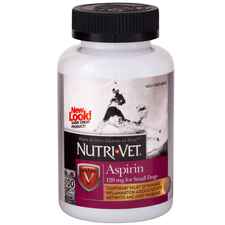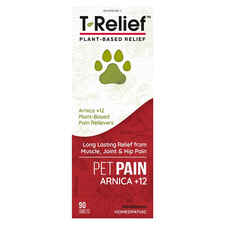Chronic Pain in Pets - Yes, It’s Manageable!
Doctor of Veterinary Medicine

While efforts are made to answer all questions as quickly as possible, if an immediate answer is required or if your pet is in need of urgent or emergency care, contact your pet's veterinarian immediately.
Doctor of Veterinary Medicine

You will receive an answer from Dr. Lindsay and our vet/tech team as soon as possible, usually the same day.
All answers are provided for informational or educational purposes only, and are intended to be a supplement to, and not a substitute for, the expertise and professional judgment of your pet's veterinarian.
It may be necessary to consult your pet's veterinarian regarding the applicability of any opinions or recommendations with respect to your pet's symptoms or medical condition.
CloseDoctor of Veterinary Medicine

An error has occurred, please reload the page and try again.
CloseWhile efforts are made to answer all questions as quickly as possible, if an immediate answer is required or if your pet is in need of urgent or emergency care, contact your pet's veterinarian immediately.
There is no answer related to your question

Pain is an inevitable part of life, and for those with chronic pain, it’s an everyday battle. Thankfully, researchers in veterinary medicine are always learning more about chronic, painful conditions in pets. In honor of Animal Pain Awareness Month, learn how you can identify, manage, and even prevent chronic pain in pets.
What is Chronic Pain in Pets?
When you touch a hot stove, you immediately feel acute pain that prompts you to pull your hand back, sometimes fast enough to avoid a severe burn. Acute pain usually serves a purpose. It’s our body’s way of stopping us from doing something that can hurt us. Pain can also force us to slow down so we can recover from an injury.
Chronic pain, on the other hand, is maladaptive, meaning it does not serve us or our pets. It’s long-lasting and may persist after an injury, or it can develop over time from a degenerative disease like osteoarthritis, hip dysplasia, or intervertebral disk disease.
Why Manage Chronic Pain in Pets
As pet parents, we do not want our pets to be in pain. But we can miss subtle signs that our pets are hurting, and we also may not know about the wide range of therapies, medications, and emerging treatments for pets. While most cats and dogs will slow down as they get older, suffering from chronic pain is not necessarily inevitable.
By managing chronic pain, we can add more healthy, happy years to our pet’s life. With the introduction of pain management therapies, many pet parents see improvements not only in their pet’s activity, but also in their behavior, their appetite, and their mood.
What Can Cause Chronic Pain in Cats and Dogs?
The most common and well-known form of chronic pain is osteoarthritis due to the breakdown of joint tissue, usually seen in older cats and dogs. Arthritis can also occur in younger pets after an injury, especially in those that are athletic.
Repeated movements like playing fetch, jumping on and off furniture, and running upstairs can contribute to wear and tear on the joints. Excess weight, too, is linked to inflammation and chronic pain.
There are also many lesser-known causes of long-term pain in cats and dogs.
Old injuries like muscle or ligament tears can leave your pet with lingering pain. For example, a dog with a cranial cruciate ligament (CCL) tear from months ago may seem as though they’ve healed because they’re no longer limping, but can still experience pain, even after surgery.
Pets with repeated urinary tract infections can suffer from idiopathic cystitis or bladder inflammation. Urinary tract issues are common in cats, especially males.
A little-known cause of chronic pain is myofascial pain syndrome, which affects the connective tissue that surrounds the muscles. The fascial tissue develops tight spots, known as trigger points, that are stiff and/or painful when touched or stretched, and does not respond to painkillers. It’s caused by repetitive movements, soft tissue injury, or inactivity.
Helping Pets With Chronic Pain
If you suspect your pet is suffering from chronic pain, your first step is to see your veterinarian. Your veterinarian can examine your pet and run blood tests, x-rays, and other diagnostics.
Never give human painkillers to cats and dogs. Human medications can cause severe gastric bleeding, seizures, and death in pets. You can find over-the-counter options like Nutri-Vet Aspirin (DOGS ONLY), or T-Relief Tablets, a natural alternative to NSAIDs. Your veterinarian can prescribe a painkiller in a formulation that’s safe for your pet.
Ask your veterinarian about therapies such as water therapy, cold laser therapy, acupuncture, and massage, which have been studied to have great results for pets with arthritis and pain from old injuries. If your vet does not offer these therapies, they might be able to refer you to a specialist.
Electrotherapy is an increasingly popular treatment that can be done at home. Assisi Loop is a device that sends a targeted electromagnetic field to the affected area and helps promote healing and pain relief.
Heat therapy is an easy, affordable at-home pain management tool. Apply a warm compress to the affected area to help increase blood flow and relax sore, tight muscles. Also, keep in mind that the cold can worsen the pain. Ice packs are better suited for acute injuries, rather than chronic pain. Also, consider getting a heated pet bed to relieve cold-induced inflammation in the winter.
Lifestyle Changes for Pets with Pain
Diet is crucial in controlling and preventing pain. Before changing or adding to your pet’s diet, talk to your veterinarian, especially if your cat or dog has a chronic condition.
Omega-3 fatty acids, found in fish oil and pet joint supplements, can lower inflammation in pets with arthritis, soft-tissue injuries, and degenerative diseases.
Hydration is important, too. Water keeps muscles loose and flexible, helps the body get rid of waste products, and aids circulation.
As your pet starts to feel better, they may act more playful and more active. Still, manage any unnecessary causes of impact and strain. Use ramps and steps to keep them from jumping on and off furniture and in cars. Avoid running and repetitive or high-impact exercise. Instead, enjoy paced, low-impact activities like walking and swimming to help your pet stay strong, flexible, and healthy.
 Swipe
Swipe



























